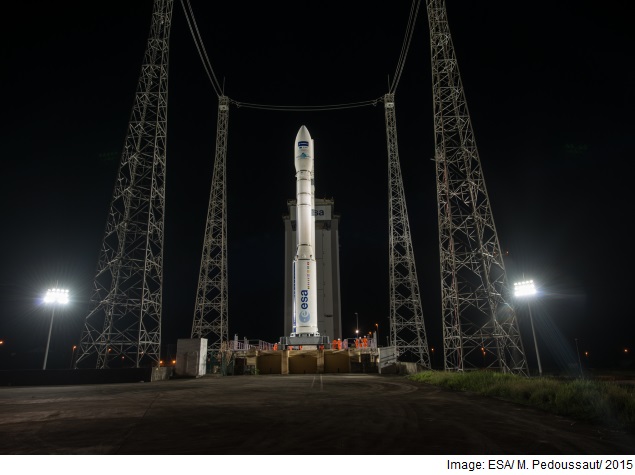- Home
- Science
- Science News
- Europe Launches Satellite to Give Earth Observation Colour Vision
Europe Launches Satellite to Give Earth Observation Colour Vision

The Sentinel-2a satellite, the second of a planned seven-member network, was launched aboard a Vega rocket from Europe's spaceport in French Guiana at 9.52pm EDT Monday (1.52am GMT or 7.22am IST Tuesday).
From its orbital perch 488 miles (786km) above Earth, the spacecraft will collect environmental data intended to help policymakers craft legislation and react to emergencies, such as natural disasters.
The Copernicus project, for which the European Union and the European Space Agency (ESA) have committed funding of around EUR 8.4 billion (roughly Rs. 60,130 crores) until 2020, is described by ESA as the most ambitious Earth observation program to date.
ESA launched the first satellites, Sentinel-1a, in April 2014, carrying radar equipment that can monitor sea ice, oil spills and land use even when skies are cloudy.
Sentinel-2a, which will operate in tandem with another satellite to be launched in late 2016, carries high-tech imaging equipment that can capture a wider range of colours than other Earth observation spacecraft, such as France's Spot 5 or the U.S. Landsat satellites.
"We have not just all the colours that are visible, but also infrared, which is very good for monitoring vegetation," Volker Liebig, director of ESA's Earth Observation program, told Reuters.
Sentinel-2a will also cover an 180-mile (290-km) swath of Earth and revisit the same point on Earth every 10 days, providing more up-to-date images than have been available, at a higher resolution of 10 meters.
The images will be used for a wide variety of programs, including locating sites for refugee camps in humanitarian crises, monitoring the destruction or growth of forests and estimating fertilizer and water needs for efficient crop production.
Liebig said ESA was working actively with international programs that seek to forecast harvests so the United Nations World Food Program can anticipate need and avoid shortages, which can cause spikes in food prices.
"When you have the information two months in advance, you can organize transports. If it's only two weeks, it's very difficult," he said.
Sentinel-2 is designed and built by a consortium of about 60 companies led by Airbus Defence and Space.
© Thomson Reuters 2015
For the latest tech news and reviews, follow Gadgets 360 on X, Facebook, WhatsApp, Threads and Google News. For the latest videos on gadgets and tech, subscribe to our YouTube channel. If you want to know everything about top influencers, follow our in-house Who'sThat360 on Instagram and YouTube.
Related Stories
- Samsung Galaxy Unpacked 2025
- ChatGPT
- Redmi Note 14 Pro+
- iPhone 16
- Apple Vision Pro
- Oneplus 12
- OnePlus Nord CE 3 Lite 5G
- iPhone 13
- Xiaomi 14 Pro
- Oppo Find N3
- Tecno Spark Go (2023)
- Realme V30
- Best Phones Under 25000
- Samsung Galaxy S24 Series
- Cryptocurrency
- iQoo 12
- Samsung Galaxy S24 Ultra
- Giottus
- Samsung Galaxy Z Flip 5
- Apple 'Scary Fast'
- Housefull 5
- GoPro Hero 12 Black Review
- Invincible Season 2
- JioGlass
- HD Ready TV
- Laptop Under 50000
- Smartwatch Under 10000
- Latest Mobile Phones
- Compare Phones
- Redmi Turbo 4
- Vivo Y200+
- Lava Yuva 2 5G
- OnePlus Ace 5
- OnePlus Ace 5 Pro
- Oppo A5 Pro 5G
- Vivo Y29 5G
- Honor Magic 7 RSR Porsche Design
- Asus Zenbook S 14
- MacBook Pro 16-inch (M4 Max, 2024)
- Honor Pad X9 Pro
- Honor Pad V9
- boAt Enigma Gem
- boAt Enigma Daze
- Sony 65 Inches Ultra HD (4K) LED Smart TV (KD-65X74L)
- TCL 55 Inches Ultra HD (4K) LED Smart TV (55C61B)
- Sony PlayStation 5 Pro
- Sony PlayStation 5 Slim Digital Edition
- Blue Star 1.5 Ton 3 Star Inverter Split AC (IC318DNUHC)
- Blue Star 1.5 Ton 3 Star Inverter Split AC (IA318VKU)

















